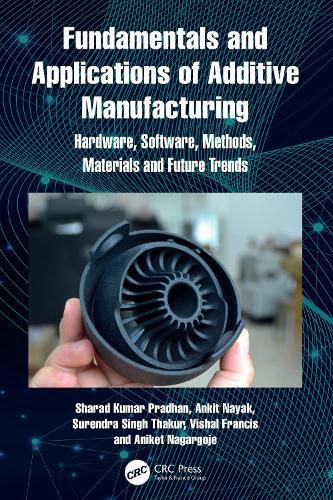Readings Newsletter
Become a Readings Member to make your shopping experience even easier.
Sign in or sign up for free!
You’re not far away from qualifying for FREE standard shipping within Australia
You’ve qualified for FREE standard shipping within Australia
The cart is loading…






Through nine chapters covering software, hardware, solid-based, liquid-based, and powder-based 3D printing processes, this textbook provides a comprehensive but easy-to-understand and application-oriented guide to the fundamentals and applications of 3D printing.
Readers are guided through various topics in a structured and logical manner that takes them from an initial comprehensive discussion of the topic to specialized chapters on advanced areas. The authors compare additive manufacturing with conventional processes; introduce computer-aided design; explore data preparation techniques including 3D printing interfaces; and provide information regarding STL files, model slicing, toolpath generation, 3D printing material, solid-liquid-powder-based 3D printing processes, post-processing techniques, advancements and future trends in 3D printing. The book also discusses printing accuracy, precision and tolerance and open-source data preparation software such as Fusion 360 and Tinkercad. To ensure readers' comprehensive understanding of the different printing methods, the book discusses solid-, liquid- and powder-based 3D printing processes and their principles, workings, applications, post-processing techniques and future trends. Images and descriptive figures effectively illustrate the concepts and processes throughout, aiding in the understanding and retention of the concepts and processes. Every chapter includes learning outcomes, discussion topics, self-check exercises and multiple-choice questions help teachers and students to assess their learning.
The broad coverage and engaging discussion format make this an ideal textbook for undergraduate and postgraduate students and an accessible reference for enthusiasts with elementary knowledge. In guiding readers from the basic concepts through to individual methodologies and printing techniques, it is invaluable to any reader who aims for a career related to any related application and industry.
$9.00 standard shipping within Australia
FREE standard shipping within Australia for orders over $100.00
Express & International shipping calculated at checkout
Stock availability can be subject to change without notice. We recommend calling the shop or contacting our online team to check availability of low stock items. Please see our Shopping Online page for more details.
Through nine chapters covering software, hardware, solid-based, liquid-based, and powder-based 3D printing processes, this textbook provides a comprehensive but easy-to-understand and application-oriented guide to the fundamentals and applications of 3D printing.
Readers are guided through various topics in a structured and logical manner that takes them from an initial comprehensive discussion of the topic to specialized chapters on advanced areas. The authors compare additive manufacturing with conventional processes; introduce computer-aided design; explore data preparation techniques including 3D printing interfaces; and provide information regarding STL files, model slicing, toolpath generation, 3D printing material, solid-liquid-powder-based 3D printing processes, post-processing techniques, advancements and future trends in 3D printing. The book also discusses printing accuracy, precision and tolerance and open-source data preparation software such as Fusion 360 and Tinkercad. To ensure readers' comprehensive understanding of the different printing methods, the book discusses solid-, liquid- and powder-based 3D printing processes and their principles, workings, applications, post-processing techniques and future trends. Images and descriptive figures effectively illustrate the concepts and processes throughout, aiding in the understanding and retention of the concepts and processes. Every chapter includes learning outcomes, discussion topics, self-check exercises and multiple-choice questions help teachers and students to assess their learning.
The broad coverage and engaging discussion format make this an ideal textbook for undergraduate and postgraduate students and an accessible reference for enthusiasts with elementary knowledge. In guiding readers from the basic concepts through to individual methodologies and printing techniques, it is invaluable to any reader who aims for a career related to any related application and industry.